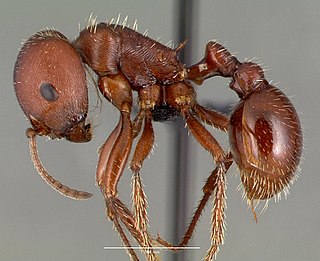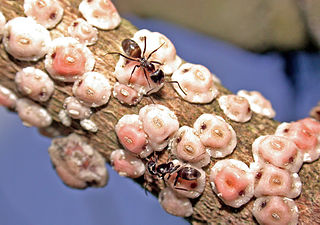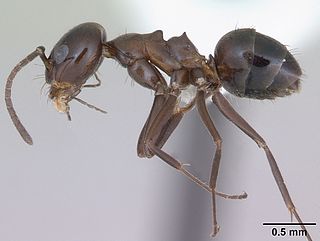
Pogonomyrmex is a genus of harvester ants, occurring primarily in the deserts of North, Central, and South America, with a single endemic species from Haiti.

Dorylus, also known as driver ants, safari ants, or siafu, is a large genus of army ants found primarily in central and east Africa, although the range also extends to southern Africa and tropical Asia. The term siafu is a loanword from Swahili, and is one of numerous similar words from regional Bantu languages used by indigenous peoples to describe various species of these ants. Unlike the New World members of the former subfamily Ecitoninae, members of this genus form temporary subterranean bivouacs in underground cavities which they excavate and inhabit - either for a few days or up to three months. Also unlike some New World army ants, driver ants are not specialized predators of other species of ant, instead being more generalistic with a diet consisting of a diversity of arthropods. Colonies are enormous compared to other army ants and can contain over 20 million individuals. As with their American counterparts, workers exhibit caste polymorphism with the soldiers having particularly large heads that power their scissor-like mandibles. They are capable of stinging, but very rarely do so, relying instead on their powerful shearing jaws. Driver ant queens are the largest living ants known, with the largest measuring between 40 - 63 millimeters in total body length depending on their physiological condition.

Dolichoderinae is a subfamily of ants, which includes species such as the Argentine ant, the erratic ant, the odorous house ant, and the cone ant. The subfamily presents a great diversity of species throughout the world, distributed in different biogeographic realms, from the Palearctic, Nearctic, Afrotropical region and Malaysia, to the Middle East, Australian, and Neotropical regions.

Dorymyrmex is a genus of ants in the subfamily Dolichoderinae.

Cephalotes is a genus of tree-dwelling ant species from the Americas, commonly known as turtle ants. All appear to be gliding ants, with the ability to "parachute" and steer their fall so as to land back on the tree trunk rather than fall to the ground, which is often flooded.

Aphaenogaster is a genus of myrmicine ants. About 200 species have been described, including 18 fossil species. They occur worldwide except in South America south of Colombia, sub-Saharan Africa, and Antarctica.

Crematogaster is an ecologically diverse genus of ants found worldwide, which are characterised by a distinctive heart-shaped gaster (abdomen), which gives them one of their common names, the Saint Valentine ant. Members of this genus are also known as cocktail ants because of their habit of raising their abdomens when alarmed. Most species are arboreal (tree-dwelling). These ants are sometimes known as acrobat ants.

Tetramorium is a genus of ants in the subfamily Myrmicinae that includes more than 520 species. These ants are also known as pavement ants.

Carebara is a genus of ants in the subfamily Myrmicinae. It is one of the largest myrmicine genera with more than 200 species distributed worldwide in the tropics and the Afrotropical region. Many of them are very tiny cryptic soil and leaf-litter inhabitants. They nest in rotten wood to which the bark is still adherent in the Afrotropical region, or may be lestobiotic nesting near other ant species. Some species are known to exist parasitically within termite nests. Little is known about the biology of the genus, but they are notable for the vast difference in size between queens and workers.

Leptomyrmecini is a tribe of Dolichoderinae ants with 16 genera and two extinct genera.

Bothriomyrmex saundersi is a species of ant belonging to the genus Bothriomyrmex. It was first described by Santschi in 1922 and is endemic to Portugal and Spain.

Dorymyrmex bituber is a species of ant in the genus Dorymyrmex. Described by Felix Santschi in 1916, the species is endemic to Argentina and Paraguay.
Dorymyrmex coniculus is a species of ant in the genus Dorymyrmex. Described by Felix Santschi in 1922, the species is endemic to Argentina.

Dorymyrmex elegans is a species of ant in the genus Dorymyrmex. Described by Trager in 1988, the species is endemic to the United States and Mexico, where it is a nocturnal species and is normally seen on cool days.
Dorymyrmex fusculus is a species of ant in the genus Dorymyrmex. Described by Santschi in 1922, the species is endemic to Argentina.

Dorymyrmex grandulus, known as the great cone ant, is a species of ant in the genus Dorymyrmex. Described by Forel in 1922, the species is endemic to the United States.

Dorymyrmex paranensis is a species of ant in the genus Dorymyrmex. Described by Felix Santschi in 1922, the species is endemic to Paraguay.
Dorymyrmex santschii is a species of ant in the genus Dorymyrmex. Described by Gallardo in 1917, the species is endemic to Argentina.

Dorymyrmex spurius is a species of ant in the genus Dorymyrmex. Described by Felix Santschi in 1929, the species is endemic to Argentina, Brazil, Paraguay and Uruguay.
Dorymyrmex steigeri is a species of ant in the genus Dorymyrmex. Described by Felix Santschi in 1912, the species is endemic to Argentina and Uruguay.















